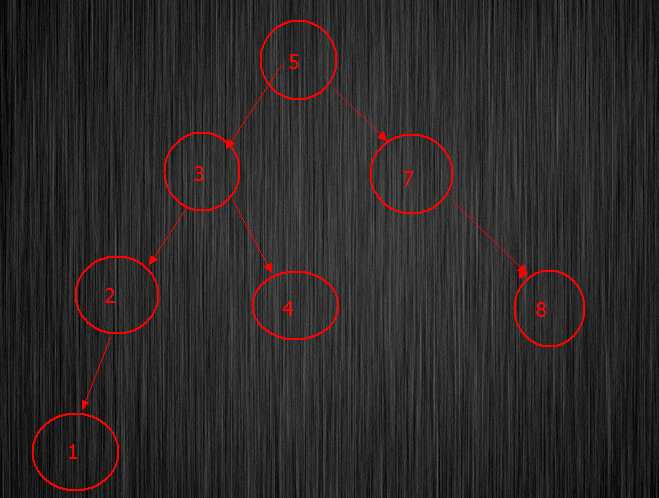标签:
什么也不说了,直接上代码。
首先是节点类,大家都懂得
/**
* 二叉树的节点类
*
* @author HeYufan
*
* @param <T>
*/
class Node<T extends Comparable<? super T>>
{
/**
* 节点储存的值
*/
private T data;
/**
* 左子节点
*/
private Node<T> leftNode;
/**
* 右子节点
*/
private Node<T> rightNode;
public Node()
{
this(null);
}
public Node(T data)
{
this.data = data;
this.leftNode = null;
this.rightNode = null;
}
/**
* @return data
*/
public T getData()
{
return data;
}
/**
* @param data
* 要设置的 data
*/
public void setData(T data)
{
this.data = data;
}
/**
* @return leftNode
*/
public Node<T> getLeftNode()
{
return leftNode;
}
/**
* @param leftNode
* 要设置的 leftNode
*/
public void setLeftNode(Node<T> leftNode)
{
this.leftNode = leftNode;
}
/**
* @return rightNode
*/
public Node<T> getRightNode()
{
return rightNode;
}
/**
* @param rightNode
* 要设置的 rightNode
*/
public void setRightNode(Node<T> rightNode)
{
this.rightNode = rightNode;
}
}
然后是二叉搜索树的实现
/**
*
*/
package dataStructure.tree.binarytree;
import java.util.LinkedList;
import java.util.Queue;
/**
* 二叉排序树
*
* @author HeYufan
*
*/
public class BinaryTree<T extends Comparable<? super T>>
{
// 二叉树的根节点
private Node<T> root;
// 二叉树的节点总数
private int size;
public BinaryTree()
{
this.root = null;
this.size = 0;
}
// 根据一个节点生成二叉树(该节点作为根节点)
public BinaryTree(Node<T> root)
{
this.root = root;
this.size = 1;
}
/**
* 插入
*
* @param value
* 要插入二叉树的值
*/
public void insert(T value)
{
root = insert(this.root, value);
}
/**
* 二叉树的节点总数
*
* @return
*/
public int size()
{
return this.size;
}
/**
* 二叉树是否为空树
*
* @return
*/
public boolean isEmpty()
{
return this.size == 0;
}
/**
* 检测二叉树的节点是否包含value
*
* @param value
* @return
*/
public boolean isContain(T value)
{
return isContain(root, value);
}
/**
* 递归比较node节点的值与value
*
* @param node
* @param value
* @return
*/
private boolean isContain(Node<T> node, T value)
{
// 如果指定节点为空,说明当前二叉树不包含value,返回false
if(node == null)
{
return false;
}
// node节点的值与value比较的结果
int result = node.getData().compareTo(value);
// 如果result等于0,说明node节点的值与value值相同,说明二叉搜索树包含value,返回true
if(result == 0)
{
return true;
}
// 如果result小于0,说明node节点的值小于value,继续递归比较node的右子节点与value
else if(result < 0)
{
return isContain(node.getRightNode(), value);
}
// 如果result大于0,说明node节点的值大于value,继续递归比较node的左子节点与value
else
{
return isContain(node.getLeftNode(), value);
}
}
/**
* 获取二叉树中的最小值
*
* @return
*/
public T getMin()
{
// 如果二叉树为空,则返回null
if(isEmpty())
{
return null;
}
return getMin(root).getData();
}
/**
* 根据二叉搜索树的性质,我们可以知道一颗二叉搜索树的最小值一定是这棵树最左边的节点
*
* @param node
* 要搜索的根节点
* @return
*/
private Node<T> getMin(Node<T> node)
{
Node<T> leftNode = node.getLeftNode();
// 如果当前节点的左节点为空,说明这个节点的值就是这棵树最小的值
if(leftNode == null)
{
return node;
}
else
{
// 否则,递归遍历当前节点的左子树
return getMin(leftNode);
}
}
/**
* 获取二叉树中的最大值(不采用递归方式,递归方式类似getMin)
*
* @return
*/
public T getMax()
{
// 如果当前二叉树为空,返回null
if(isEmpty())
{
return null;
}
Node<T> rightNode = this.root;
// 判断当前节点(从root节点开始)是否有右子节点
// 如果没有,说明当前节点的值就是该二叉搜索树的做大值,当前循环结束
// 否则,让rightNode指向当前节点的右子节点,继续while循环
while (rightNode.getRightNode() != null)
{
rightNode = rightNode.getRightNode();
}
return rightNode.getData();
}
/**
* 将值value插入到以node为根节点的二叉树下
*
* @param node
* 目标子树的根节点
* @param value
* 要插入的值
* @return 这里返回的node其实就是更新后的根节点
*/
private Node<T> insert(Node<T> node, T value)
{
// 如果要插入的目标根节点为null,则这个节点就是要插入值的地方
if(node == null)
{
node = new Node<T>(value);
this.size++;
return node;
}
// 0表示value等于node的值;-1表示value小于node的值;1表示value大于node的值
int result = value.compareTo(node.getData());
if(result < 0)
{
// 当value小于node的值,则将value插入到node节点的左子树中,此时value的目标节点就是node.getLeftNode()
node.setLeftNode(insert(node.getLeftNode(), value));
}
else if(result > 0)
{
// 当value大于node的值,则将value插入到node节点的右子树中,此时value的目标节点就是node.getRightNode()
node.setRightNode(insert(node.getRightNode(), value));
}
else
{
// 如果result = 0,说明插入的值已经存在了,可以选择更新值或者什么也不做
}
return node;
}
/**
* 先序遍历
*/
public void preorder()
{
preorder(root);
}
/**
* 后序遍历
*/
public void postorder()
{
postorder(root);
}
/**
* 中序遍历
*/
public void inorder()
{
inorder(root);
}
/**
* 层序遍历
*/
public void level()
{
if(root == null)
return;
Queue<Node<T>> queue = new LinkedList<Node<T>>();
queue.add(root);
Node<T> node = null;
while (queue.size() != 0)
{
node = queue.poll();
System.out.println(node.getData());
if(node.getLeftNode() != null)
queue.add(node.getLeftNode());
if(node.getRightNode() != null)
queue.add(node.getRightNode());
}
}
/**
* 先序遍历:遍历以node为根节点的子树 先打印节点的值,再遍历节点的左子树,最后遍历节点的右子树
*
* @param node
* 要遍历的子树的根节点
*/
private void preorder(Node<T> node)
{
if(node == null)
{
return;
}
else
{
// 打印节点的值
System.out.println(node.getData());
// 递归遍历该节点的左子树
preorder(node.getLeftNode());
// 递归遍历该节点的右子树
preorder(node.getRightNode());
}
}
/**
* 后序遍历:遍历以node为根节点的子树;先遍历节点的左子树,再遍历节点的右子树,最后打印节点的值
*
* @param node
* 要遍历的子树的根节点
*/
private void postorder(Node<T> node)
{
if(node == null)
{
return;
}
else
{
// 递归遍历该节点的左子树
postorder(node.getLeftNode());
// 递归遍历该节点的右子树
postorder(node.getRightNode());
// 打印节点的值
System.out.println(node.getData());
}
}
/**
* 中序遍历:遍历以node为根节点的子树;先遍历左子树,再打印节点的值,最后遍历右子树
*
* @param node
*/
private void inorder(Node<T> node)
{
if(node == null)
{
return;
}
else
{
// 递归遍历该节点的左子树
inorder(node.getLeftNode());
// 打印节点的值
System.out.println(node.getData());
// 递归遍历该节点的右子树
inorder(node.getRightNode());
}
}
}
测试:
/**
*
*/
package dataStructure.test;
import dataStructure.tree.binarytree.BinaryTree;
/**
* @author Administrator
*
*/
public class TestBinaryTree
{
public static void main(String[] args)
{
BinaryTree<Integer> tree = new BinaryTree<Integer>();
tree.insert(5);
tree.insert(3);
tree.insert(2);
tree.insert(7);
tree.insert(8);
tree.insert(4);
tree.insert(1);
tree.insert(4);
tree.insert(1);
System.out.println("是否包含1:" + tree.isContain(1));
System.out.println("是否包含10:" + tree.isContain(10));
System.out.println("树的节点数:" + tree.size());
System.out.println("树的最大值:" + tree.getMax());
System.out.println("树的最小值:" + tree.getMin());
System.out.println("先序遍历:");
tree.preorder();
System.out.println("后序遍历:");
tree.postorder();
System.out.println("中序遍历:");
tree.inorder();
System.out.println("层序遍历:");
tree.level();
}
}
树的结构:

输出结果:
是否包含1:true
是否包含10:false
树的节点数:7
树的最大值:8
树的最小值:1
先序遍历:
5
3
2
1
4
7
8
后序遍历:
1
2
4
3
8
7
5
中序遍历:
1
2
3
4
5
7
8
层序遍历:
5
3
7
2
4
8
1
Java实现二叉搜索树的添加,前序、后序、中序及层序遍历,求树的节点数,求树的最大值、最小值,查找等操作
标签:
原文地址:http://www.cnblogs.com/fange666/p/4388945.html